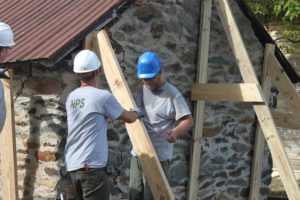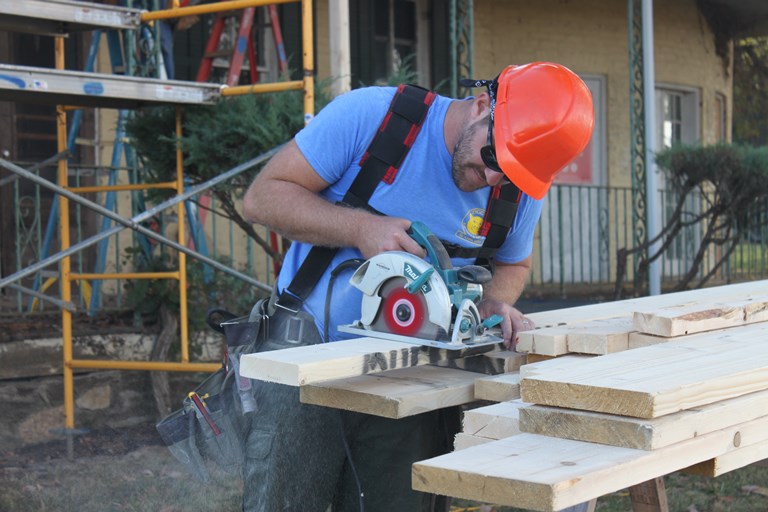An occupation is the principal activity one engages to earn money. A profession is an occupation requiring special knowledge or skill. At the time writing this, historic trades are not an official occupation. For example, a carpenter has a job code on the Occupation Information Network, O*NET: 47-2031.00 – Carpenters. It explains what a carpenter does, their knowledge, skills, and abilities, as well as employment data, like wages and job prospects.
By contrast, a “preservation carpenter” is not a classified occupation. It does not exist on O*NET. There are no nationally-recognized standards for what a preservation carpenter is, does, or earns. Without this fundamental occupational information, there is no professional level information either. This pattern exists across different trades, such as masonry, roofing, window work, painting, and more.

Craftsmen stabilizing a historic meat shed at Shafer Farm, 2017.
It is untrue to conclude that “preservation carpenters” don’t exist because they aren’t listed on O*NET. Preservation carpenters are gainfully employed across the country, and their work requires special knowledge and skills. However, to non-preservation institutions, it appears that preservation carpenters do not exist and do not need to. These classifications are important because they provide labor data, justify training programs, and determine tax and insurance classifications. Preservation carpentry should be an official profession.This is the dilemma we face.

The Campaign’s Program Manager, Natalie Henshaw
The Campaign is a unique workforce development initiative because it seeks to create the occupation as it simultaneously defines and expands the profession. It also encompasses multiple trades specialties. A preservation carpenter performs different tasks than a preservation mason. Geographically this changes as well–a preservation mason in Massachusetts can work with entirely different materials and tools than a preservation mason in New Mexico. How do we coalesce these under one professional umbrella?The Campaign is tackling these monumental challenges in multifaceted ways, both short term and long term. Our short term goal is to create historic trades apprenticeships. Registering an apprenticeship creates a job classification on O*NET and provides national standards on what historic trades people are, do, and earn.
The Campaign also partners with industry trades groups to integrate preservation training components into existing training programs. A preservation ethos threads these different trades skills and industries. This will have a large and lasting impact by engaging a wide audience about how to be good stewards of historic structures and materials.
Interested in learning more? Historic Trades Program Manager Natalie Henshaw is presenting September 24th, 2021 for Preservation League of NYS Workforce Development Webinar. Attendance is free: ZOOM LINK
Panelists will share their experience managing successful workforce training programs focused on historic preservation skills. A moderated conversation will dive into the importance of this training in making sure future generations have the skills necessary to bring our historic buildings into the future.

